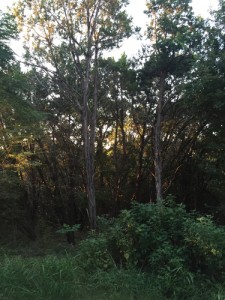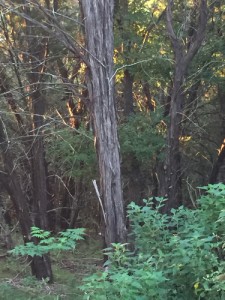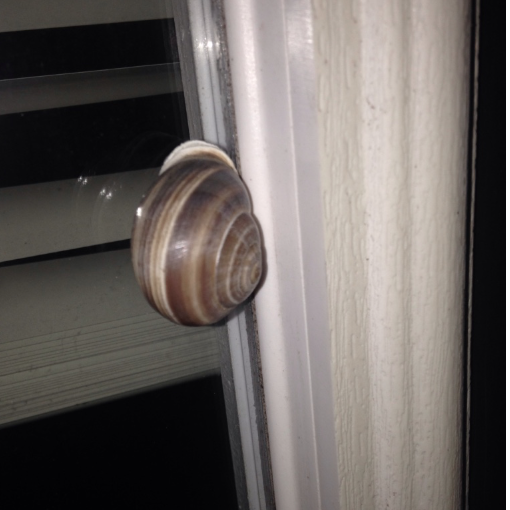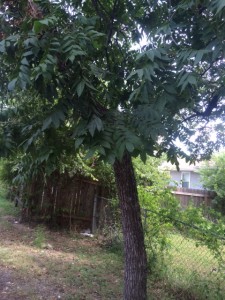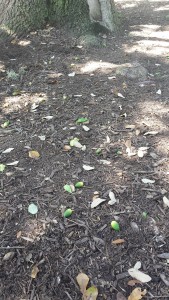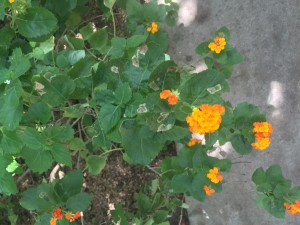This Ashe Juniper (Juniperus ashei) was found just behind my apartment complex in Austin, TX, where an abundance of this non-native species can be observed yearly. It is tough to determine whether or not to love this species!Because it is non-native to this area, it takes up natural resources that native trees need, but it also provides homes to species prevalent to Austin, such as the protected Golden Cheek Warbler.
Seven-spotted Ladybird
“Ladybird? What’s a ladybird?” Upon identifying my first species for this blog, I was confused at this name. Also, I quickly learned that the general term ‘ladybug’ that we all know and use isn’t actually correct. They are actually lady beetles! This lady beetle in particular is called a seven-spotted ladybird (Coccinella septempunctata). While I normally think of seeing ladybugs…beetles…as a pretty neat and rare occurrence, this time was quite different. I found these on a patch of over grown grass along a fairly busy road that sways the grass violently every time a car passes. And yet, there were many of these present in this grassy area, full grown and in the larva state, too. After posting my observation on iNaturalist, I found out that this species was introduced to Travis county by anthropogenic means. According to another website , they are classified as non-native. They are thought to have impacts on other Coccinella species, having outcompeted certain native species in North America. So now whenever I see this certain type of ladybug/beetle/bird, instead of thinking about how cute a beetle can seem to be, I will think more about the broader impacts it could have on species composition in certain ecosystems.
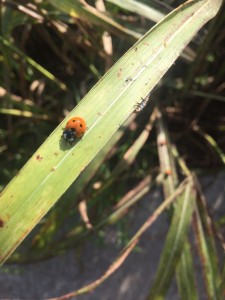
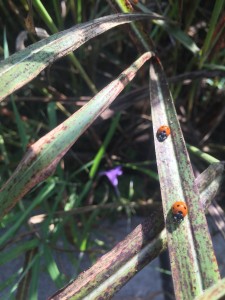
References: http://texasento.net/TXCoccinellidae.htm; http://www.inaturalist.org/taxa/51702-Coccinella-septempunctata
Milk Snail
This little guy is a milk snail (Otala lactea). The shell colors of milk snails can be highly variable, but they are usually shades of brown. They are nocturnal herbivores. They are an invasive species, thought to have been introduced to Florida in the early 1900’s from the eastern Mediterranean or northern Africa. Though it is found in smaller populations and less frequently in Texas, they can be problematic in more Mediterranean – like climates, such as California. They can out-compete native snails for habitat.
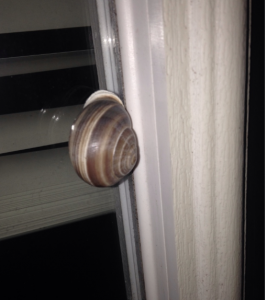 They are edible, and at various times have been a very popular dish in Europe, from Spain to Morocco. One idea as to how to control the population in California is to put them on the menu in local restaurants.
They are edible, and at various times have been a very popular dish in Europe, from Spain to Morocco. One idea as to how to control the population in California is to put them on the menu in local restaurants.
The preferred habitat of milk snails is rocky, bushy shrubland or grassland, but this one has been chilling on our patio door.
The link to my iNaturalist observation can be found here.
Reference: http://www.tsusinvasives.org/home/database/otala-lactea
Texas Prickly Pear
Coming from a region where cacti are just potted plants to be kept inside, it was unusual to see cacti growing naturally outside and this particular cactus can grow up to 5-7 feet. Texas prickly pear is under Opuntia genus and there are about dozen species of prickly pear cacti, and they can be found in the Southwest because of its dry soil. More information on prickly pear cactus can be found here.
Even though there are immature pears growing right now, this cactus blooms yellow/orange flowers and eventually, purple pears when they matures. Prickly pears are important food for animals; bees, birds and even humans, pears can be roasted, preserved, or processed as syrup. Prickly pear cactus can be used in many different ways, no wonder why it is Texas state plant.
My iNaturalist observation can be found here.
Resources:
Mexican Bush Sage
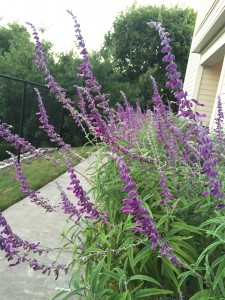 Because of its striking color, the Mexican Bush Sage, Salvia leucantha, caught my eye this evening during my walk around the apartment complex. This herbaceous perennial is native to Mexico and Central America but it’s particularly well adapted to the climate of central Texas. What makes this shrub unique is the fact that it is deer-resistant, while also providing food and shelter to birds, butterflies, and bees. The bright purple flowers bloom from summer to late fall, and the shrub can reach heights between 3′ and 5′. Because of its outstanding beauty and low maintenance, the Mexican bush sage has become very popular for landscaping, especially in the Austin area. It has also been the recipient of numerous awards, including being named a Texas Super Star.
Because of its striking color, the Mexican Bush Sage, Salvia leucantha, caught my eye this evening during my walk around the apartment complex. This herbaceous perennial is native to Mexico and Central America but it’s particularly well adapted to the climate of central Texas. What makes this shrub unique is the fact that it is deer-resistant, while also providing food and shelter to birds, butterflies, and bees. The bright purple flowers bloom from summer to late fall, and the shrub can reach heights between 3′ and 5′. Because of its outstanding beauty and low maintenance, the Mexican bush sage has become very popular for landscaping, especially in the Austin area. It has also been the recipient of numerous awards, including being named a Texas Super Star.
My iNaturalist observation can be found here.
Resources
http://www.finegardening.com/mexican-bush-sage-salvia-leucantha
http://austinnativelandscaping.com/salvia-leucantha-mexican-bush-sage/
Pecan Tree
The Pecan tree, or Carya illinoinensis, is a large deciduous tree related to hickory tree species, and it is native to Mexico and the southeastern and southcentral regions of the U.S. Its fruit, the pecan, is also an important food source for many animals. As the tree is particularly native to Texas, Pecan also happens to be the official State Tree of Texas. More on the Pecan tree can be found here.
Being someone that holds both native flora and Texas near and dear to their heart, I was happy to spot this familiar friend behind my apartment building in the Hyde Park neighborhood. It always catches my eye with its long and dark green leaves, and its green to brown fruit. I usually keep an eye out for brown pecans on the ground because depending on how ripe the fruit is, that could be a snack.
My iNaturalist observation can be found here.
Texas Live Oak
 This Live Oak tree, Quercus fusiformis, resides next to my apartment complex (not ironically called Tree). According to this rough age determination equation, and based on the tree’s approximate diameter, it’s estimated age could be anywhere from 150 – 235 years old. This is a VERY rough estimation as my method to measure the tree’s diameter was to literally hug it.
This Live Oak tree, Quercus fusiformis, resides next to my apartment complex (not ironically called Tree). According to this rough age determination equation, and based on the tree’s approximate diameter, it’s estimated age could be anywhere from 150 – 235 years old. This is a VERY rough estimation as my method to measure the tree’s diameter was to literally hug it.
Texas live oaks are monoecious, with the male flowers forming catkins up to 3″ long and the female flowers forming a peduncle 1″ to 3″ long in the leaf axils (the upper angle where the leaf meets the stem). Once a female flower is fertilized it forms an acorn, which can be seen in the picture below. Very few acorns survive to grow into a young oak because they represent an important food source for rodents, birds, insects, and fungi. iNaturalist post found here.
Texas lantana
This plant, Lantana Urticoides, always catches my eye while walking around St. Edward’s campus. This decidious shrub has orange and yellow flowers appearing from April to October. It is native and thrives in Arizona and Texas because it is drought tolerant and resistant to disease, pests, and deer. Because of these traits, some may call this plant a pesky weed, but, to me, the flowers are colorful and eye-catching. They also attract butterflies, bees, and birds, providing food and shelter.
My iNaturalist post can be found here
Cacti or Succulent?
While trying to identify the plant pictured below I discovered that, all cacti are succulents, but not all succulents are cacti (CactiGuide.com). Cacti has become a term commonly used to describe any prickly-looking desert plant. But there are differences between the two. Cacti (Cactaceae) have small, round structures called areoles from which spines, branches, hairs, leaves and flowers grow. Succulents do not have areoles (ucdavis.edu). Cacti are also only native to the Americas, from Alaska south to Chile. This includes species of cacti that have adapted to survive the freezing winters common to Canada (ucdavis.edu). Succulents on the other hand are native to most parts of the world (ucdavis.edu).

The Century Plant (Agave americana) is a native Texas agave (succulent) and described by some as the largest and most majestic of the native Texas agaves (aggie-horticulture.tamu.edu). Agave americana lives for 10 to 25 years and at the end of its life produces a flower stalk up to 15 feet tall (aggie-horticulture.tamu.edu). It is moderately slow growing, extremely drought tolerant and tolerant of temperatures as low as 20°F (aggie-horticulture.tamu.edu). It is frequently used in landscaping, as it is in the picture above.
Resources
http://aggie-horticulture.tamu.edu/ornamentals/nativeshrubs/agaveamer.htm
http://www.cactiguide.com/cactiornot/
http://ucce.ucdavis.edu/universal/printedprogpageshow.cfm?pagenum=6142&progkey=2080&county=5576
Red Bird of Paradise
Caesalpinia pulcherrima is a semi-evergreen shrub that occurs all throughout Texas, Arizona and much of the southern United States. This particular shrub caught my eye for two reasons. First, the bright orange and yellow colors are attention grabbing but also serve as a warning of their poisonous seeds. The second reason this shrub caught my attention was for it’s long stamen, which extend far beyond the petals and allow for easy pollination by bees and butterflies.
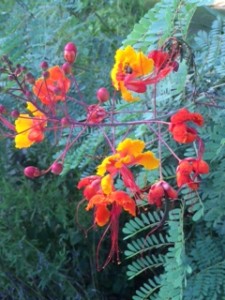
The Inaturalist post can be found here
